Description:
The third coin in the Austrian Mint’s four-coin Empress Maria Theresa – Treasures of History series features the only ever female ruler of the Habsburg Empire wearing a widow’s veil. Empress Maria Theresa donned the veil following the sudden death of her beloved husband, Francis I, in 1765. Like the other coins in the series, “Clemency and Faith” has been inspired by medals issued during the Empress’ reign and minted in extra-bold relief, which gives it a special antique look and feel worthy of its illustrious subject.
The Austrian Mint’s “Empress Maria Theresa” Coin Program: Maria Theresa Taler Silver Proof – Courage & Determination – Justice & Character (2017) | Clemency & Faith (2018)
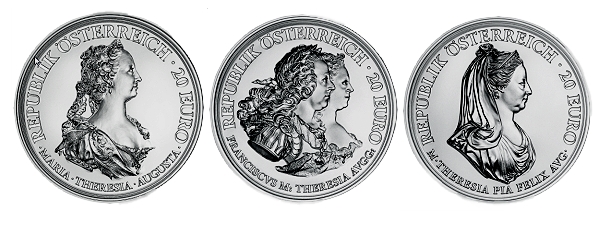
Mournful Monarch
Devastated by the death of Francis, Maria Theresa dressed in mourning for the rest of her life and even had the room in which he died, in the Hofburg in Innsbruck, converted into a chapel. The portrait of Maria Theresa wearing a veil on the coin’s obverse is from a relief by Anton Guillemard (1747-1812), while the coin’s reverse shows an allegorical representation of Clemency in which a female figure offers her hand to a fallen soldier. Celebrating the 300th anniversary of the birth of Empress Maria Theresa in 1717, the four-coin Empress Maria Theresa series is based on the four cardinal virtues, which drove the Empress. Featuring an amalgam of original motifs taken from medals issued during Maria Theresa’s 40-year reign (1740-1780), the coins combine Courage, Justice, Clemency and Prudence with four different portraits of the Empress: as a young woman; as a wife; as a widow; and with her successor, Joseph II.
Obverse:
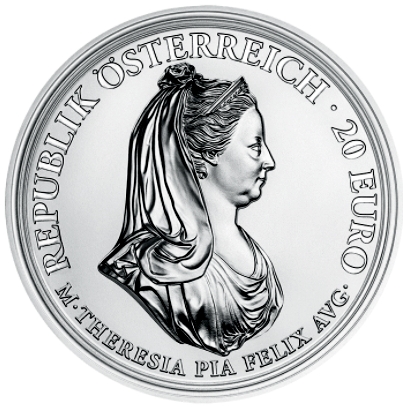 The primary design element of the obverse is, of course, the right-facing portrait of a matronly yet regal-looking Maria Theresa. Here she wears a tiara and a veil that covers much but not all of her hair. Encircling her portrait along the top of the obverse are the inscriptions REPUBLIK ÖSTERREICH and 20 EURO separated by a small dot. Cradled beneath the truncation of her bust (which seems to fade out in a cinematic way near the edges versus a clear-cut dividing line) is the inscription M * THERESIA PIA FELIX AVG *, which is an abbreviation of “Maria Theresia Pia Felix Augusta” (“Maria Theresa Loving Happy Empress” in Latin).
The primary design element of the obverse is, of course, the right-facing portrait of a matronly yet regal-looking Maria Theresa. Here she wears a tiara and a veil that covers much but not all of her hair. Encircling her portrait along the top of the obverse are the inscriptions REPUBLIK ÖSTERREICH and 20 EURO separated by a small dot. Cradled beneath the truncation of her bust (which seems to fade out in a cinematic way near the edges versus a clear-cut dividing line) is the inscription M * THERESIA PIA FELIX AVG *, which is an abbreviation of “Maria Theresia Pia Felix Augusta” (“Maria Theresa Loving Happy Empress” in Latin).
Three solid rings (two thin outer rings and a thicker middle ring) surround the entire side.
Reverse:
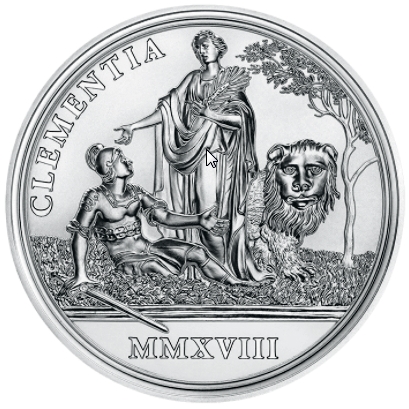 A personification of Clemency in classical dress holds a palm frond to her breast with her left arm while extending her right arm out to a fallen Roman soldier sitting on her right (viewer’s left) in the lush grass of the scene. Behind her on her left and looking directly at the viewer is a stylized medieval lion, whose front half only is visible. To the lion’s left on the right side of the coin is a slim young tree, which may or may not be an oak depending on the stylized shape of the leaves in the canopy.
A personification of Clemency in classical dress holds a palm frond to her breast with her left arm while extending her right arm out to a fallen Roman soldier sitting on her right (viewer’s left) in the lush grass of the scene. Behind her on her left and looking directly at the viewer is a stylized medieval lion, whose front half only is visible. To the lion’s left on the right side of the coin is a slim young tree, which may or may not be an oak depending on the stylized shape of the leaves in the canopy.
The Latin word for clemency (CLEMENTIA) is inscribed clockwise along the upper left rim. Beneath three solid lines or bars, in the exergue, is the date 2018 in Roman numerals (MMXVIII).
Edge:
The edge of the 2018 Maria Theresa: Clemency and Faith 20 euro silver coin is smooth.
Biography:
Empress Maria Theresa was born in Vienna, Austria on May 13, 1717. Her father was the Holy Roman emperor Charles VI, the last surviving male to bear the name Habsburg. Because of this, Charles continued to hope for a boy to continue the royal line (he had two more daughters), never preparing Maria for anything other than being someone else’s queen.
Which was strange, considering that Charles had issued his Pragmatic Sanction in 1713–four years before Maria Theresa was born. The sanction attempted to make it legal for a female to inherit the Habsburg domains. He then spent the rest of his life making territorial and diplomatic concessions in order to secure its acceptance by the courts and rulers of Europe.
When Charles died in 1740, Maria Theresa inherited the Habsburg domains, but her father had left the country bankrupt. Moreover, several major European powers (including France and Prussia) immediately reneged on the agreements they had made with Charles VI and contested her right to rule, initiating the War of Austrian Succession.
One important note: all Maria Theresa had inherited was sovereignty over Habsburg lands. She had not become monarch over the Holy Roman Empire. For one thing, it was an elected office; for another, women weren’t eligible to vote and could not become empresses in their own rights. She did, however, maneuver to support her husband Francis Stephen’s claim to the throne by making him co-ruler of Austria and thereby giving him formidable rank and real estate holdings within the Empire (he was originally from France).
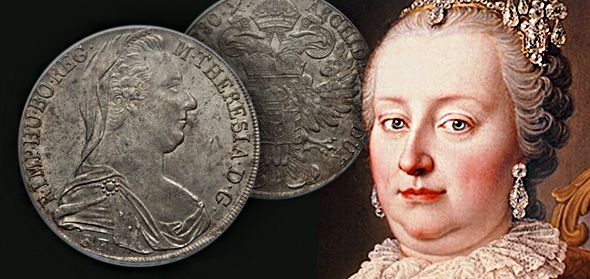
Yet while the precariously-positioned ruler of a ruined economy might seem an odd choice for numismatic immortality, it was in the first year of her reign that the silver Maria Theresa thaler made its debut. It was quickly accepted throughout the German-speaking realms of Europe, and eventually became the widest used trade dollar in the planet’s history.
The first few years of the war served up major losses for Maria Theresa and her cause, with the loss of important territories and even one of her enemies being elected Holy Roman emperor. To gain much-needed support from Hungary, she adopted the masculine titles of archduke and king.
It also helped that by this time she had produced a male heir.
Still, after eight battering years and humiliating peace treaties, Maria Theresa–through determination and force of will (and often while pregnant)–managed to hold on to her family’s domains and get her husband elected emperor.
The Seven Year’s War followed eight years later. Known as the French and Indian War in the United States, it was arguably a “World War”. Maria Theresa sought to regain territory lost to Prussia in the previous war, and convinced Russia and France to go to war against Prussia and Britain. Austria lost, but besides failing to recapture the lost territories the country didn’t suffer any political setbacks.
The rest of the world, however, was changed considerably as Great Britain became the dominant power in the New World, setting the stage for the eventual rise of the United States of America.
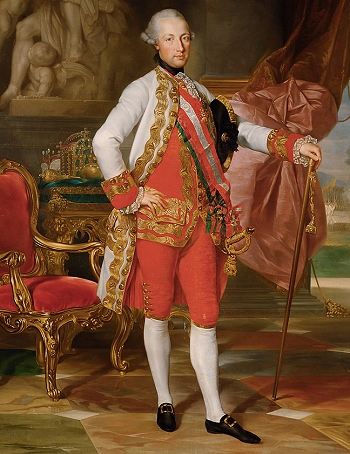 Her husband Francis died in 1765 and her son Joseph became emperor. Maria Theresa made him co-ruler as well, for similar reasons. And similarly to countless other co-regents throughout history, they didn’t get along.
Her husband Francis died in 1765 and her son Joseph became emperor. Maria Theresa made him co-ruler as well, for similar reasons. And similarly to countless other co-regents throughout history, they didn’t get along.
During her reign, she successfully reorganized Austria’s economy by taxing the nobility and reformed the military by establishing a standing army. After two of her daughters died of smallpox and she herself contracted the disease in the epidemic of 1767, Maria Theresa introduced smallpox inoculation to Austria. She instituted mandatory public schooling for children in 1775 (though she failed to fund it). A religious conservative, she nonetheless outlawed witch burning in 1776. No fan of the Enlightenment, she still managed to make Austria a culturally important and modernizing force in the world of the 19th century.
She died in 1780, the last of the Habsburg line. She was survived by 11 of her 16 children, including Marie Antoinette. A date freeze was implemented on all Maria Theresa thalers produced after her death.
In 1857, her great-great-grandson, the emperor Franz Joseph I, gave the Maria Theresa silver thaler its official status as a trade dollar. The coins were so important to global commerce that numerous mints around the world have minted Maria Theresa thalers for commercial use. Maria Theresa thalers were especially popular in Africa and the Arab World, serving as legal tender in many nations until very recently.
* * *
Austrian Mint designer Helmut Andexlinger is one of the world’s leading coin designers. He has created a number of prize-winning coin designs (View Designer’s Profile).
Herbert Wähner is a designer and engraver at the Austrian Mint. Both men studied at the Fachschule für Metalldesign in Steyr, Austria.
Coin Specifications:
| Country: | Austria |
| Year Of Issue: | 2018 |
| Denomination: | 20 Euro |
| Mint Mark: | |
| Mintage: | 30,000 |
| Alloy: | .925 (Sterling) Silver |
| Weight: | 22.42 grams |
| Diameter: | 34.00 mm |
| Edge: | Smooth |
| OBV Designer | Anton Guillemard | Helmut Andexlinger | Herbert Wähner |
| REV Designer | Helmut Andexlinger | Herbert Wähner |
| Quality: | Proof (Polished Plate) |
Keep up with all the latest coin releases from the world mints by clicking on CoinWeek’s World Coin Profiles Page.





